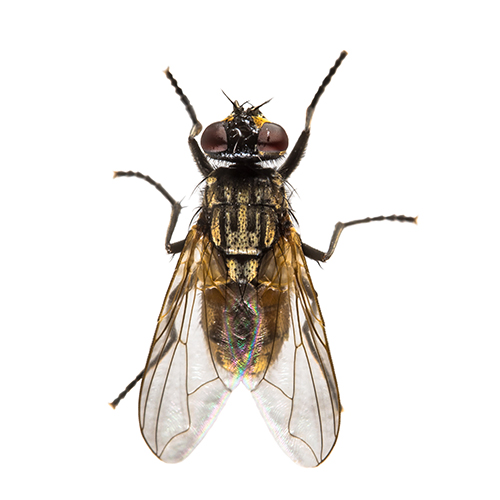Flies

FLIES (Musa Domestica)
Description:
There are many types of flies in Southern California. Flies have two pairs of wings, ranging from black-green to shiny blue. They are generally associated with filth, garbage, and decaying matter. The common housefly is the most often seen in domestic and commercial environments. Adults are gray to grayish-black, are about 1/4 of an inch long and their clear wings have a distinctive vein pattern.
Biology:
All flies are associated with unsanitary conditions and can be disease carriers. When feeding, flies regurgitate some of their stomach contents onto their food, then suck it back into their stomach. While walking and feeding on garbage, fecal material, and food, flies transfer disease organisms from both inside and outside their bodies. Flies are associated with more than a dozen different diseases. An adult fly can lay 500 eggs in 4 days. In warm weather, a fly's life cycle from egg to adult is approximately 8 to 12 days.
Did You Know?
If a single pair of breeding flies began reproducing in April, and all their offspring lived and reproduced at the same rate, it would result in 191,010,000,000,000,000,000 (191 quintillion, 10 quadrillion) flies by August. If you put them end to end in a line they would wrap around the earth 2 billion times!
Impact:
Predators, parasites, and several other factors drastically reduce fly populations. Still, in uncontrolled conditions, there can be thousands of flies. Flies suggest unsanitary conditions, promoting pathogens, diseases, contamination, and odors. For that reason, fly infestations come under Health Department guidelines. The economic impact of uncontrolled fly infestations on commercial, industrial, or office property can be significant and needs to be addressed with appropriate controls.
Solutions:
Our professionals provide a meticulous inspection regimen, sanitation advice, follow-ups, baits, and appropriate insecticides. An effective pest control program requires mutual effort from owners, managers, and a professional pest management service.
Additional Links:
http://www.ipm.ucdavis.edu/PMG/PESTNOTES/pn7457.html
